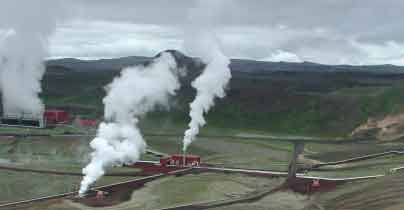A research and development program in Iceland could make high-temperature geothermal resources more economically feasible.
Geothermal energy is derived from underground water heated naturally by contact or close proximity to molten rock, deep beneath the earth’s surface.
Supported by Alcoa, the Iceland Deep Drilling Project (IDDP) consortium will collaborate on a deep drilling pilot project which will investigate the economic feasibility of producing energy and useful chemicals from geothermal systems at what are known as “supercritical conditions”.
These natural systems, where underground water becomes super-heated by close proximity to almost molten rocks, could potentially produce up to ten times more electricity than the geothermal wells typically in service today.
The IDDP consortium is composed of three leading Icelandic power companies: Hitaveita Sudurnesja, Landsvirkjun and Orkuveita Reykjavikur, together with Orkustofnun (National Energy Authority) and Alcoa.
To produce energy from supercritical fluids requires drilling to depths of 4 to 5km to reach fluid temperatures of 400–600°C. Today, typical geothermal wells are about 2km deep, and produce steam at about 300°C - a rate sufficient to generate about 5MW of electricity. It is estimated that producing steam from a well penetrating a reservoir at or above 450°C temperature and at a rate of 0.67 cubic meters a second, could generate 40-50MW of electricity.

Each of the power companies, which financed a pre-feasibility study that was completed in 2003, have committed to drill at their own costs one 3.5-4.0km deep well in a geothermal field they operate. These wells will be designed for deepening to 4.5-5.0km. One of the wells selected for further deepening is a joint IDDP-project funded by the consortium with additional funds from the International Continental Scientific Drilling Program, an international foundation based in Germany that supports drilling on land for scientific research, as well as the US National Science Foundation.
The first wells will be drilled in 2008 at Krafla in north-east Iceland and tested the following year. Two new wells, 4km deep, will then be drilled at Hengill and Reykjanes geothermal fields during 2009-2010, and, subsequently, deepened.
Pilot plant testing is expected to be completed in 2015.










Comment: The UK is closer to deindustrialisation than reindustrialisation
"..have been years in the making" and are embedded in the actors - thus making it difficult for UK industry to move on and develop and apply...